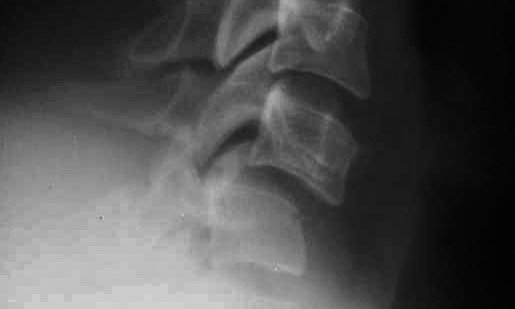Modern radiograph of a patient with a C6-C7 cervical dislocation.
Patients sustaining cervical spine dislocations or fractures are usually immobilized at the scene with a cervical collar and a backboard and transported to a medical facility where they undergo cervical X-rays, a cervical CT scan, and possibly a cervical MRI. Treatment frequently consists of cervical reduction using traction followed by surgical fusion. Case reports on the treatment of cervical spine injuries over 100 years ago are rare. Thus the importance of the detailed case managed by Balfour Fergusson, MD, and published in the Lancet on July 8, 1899:
"At midnight on June 17th I was called to see a laborer. It appeared that he was working away from home and was in the habit of returning every Saturday night. On the evening in question, he was returning home in charge of a horse and cart and, probably overcome by a week's hard work in the hayfield, he fell asleep while sitting on the edge of the cart." Two men found the laborer lying on the ground "groaning and complaining of his neck" and walked him home. There Dr. Fergusson found him "sitting on a chair with his head well bent backwards and resting against a wall. His skin was cold and clammy; his breathing was diaphragmatic; his pulse was soft, slow, and compressible; and his pupils were dilated and did not readily react to light. He had partially lost power in his arms and legs and he appeared to be dazed. His head was inclined backwards, the occiput resting on the spine."
When Dr. Fergusson tried correcting the position the patient’s neck, "he was thrown into violent spasm, the spasmodic contraction lasting a few minutes, the patient calling out all the time "Oh my neck!"
Dr. Fergusson's description of the reduction:
Securing the assistance of a parish nurse (who is, by the way, an unusually strong woman) and placing her in front of the patient I directed her to take both of his hands and to pull him directly upwards. I placed myself behind and supported his head and pressed his shoulders forwards. So great was the spasm produced by this attempt that the nurse was forcibly drawn across the bed and I was pressed backwards against the iron framework at the top, the poor fellow calling all the time, "Oh, my poor neck. Doctor, I am dying!" I as quickly as possible got him again into the sitting position and placing my left hand underneath his chin and my right behind the nape of the neck I jerked the head upwards, at the same time forcibly bending the head forwards over the chest. A sensation of a bone slipping into its place was communicated to the hand and I felt certain that the dislocation had been reduced.
The patient noted immediate improvement, and within two weeks, the patient was "now out of doors and walking." At the end of the report, Dr. Fergusson makes a few comments about injuries to the cervical spine and notes many are associated with fractures. Of particular interest is the statement that when injuries occur "between the atlas and axis, the odontoid is almost invariably fractured, death quickly ensuing."
The Lancet published the note due to "the rarity of the conditions found on this occasion."





